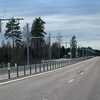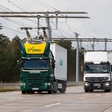

On E16, between the cities of Kungsgården and Sandviken in Gästrikland, Sweden, they are opening the world's first electric highway. It works similarly to the electric system used with trams - technology that has been around for cca. 120 years, but this is the first time that it's being used for powering large, heavy transport vehicles on a high-speed, public road.
On Scania's new heavy trucks they have mounted a pantograph behind the driver's cab, which is connected to the truck's regular propulsion system. The function of the pantograph on the roof of the truck is to feed the electricity to an electric hybrid system. It is able to connect automatically at speeds of up to 90km/h. When the truck leaves the electrical network, it returns to its diesel hybrid mode.
The pantographs get their power from the electric cable line above the road with the designated lane kept separated from other driving lanes. It is equipped with poles, 60 meters apart, holding up electricity cables in the right driving lane. The poles are protected by a railing. At the road stop by the highway there is also a charging station available – it works autonomosly, but during the testing period, it will be supervised by technicians. The road stop also features a demonstration track, where drivers can see how the process of braking and starting of a truck looks like with the help of a pantograph.
This project is a collaboration between industry, academia and government, and coordinated by Region Gävleborg. The main sponsors of the project are the Swedish Energy Agency, Scania and Siemens. It was prompted by the Swedish Transport Agency, the the Swedish Energy Agency and Vinnoa that have ordered a report detailing how Swedish road transport systems can continue to be developed in the future, and whether an electric road for heavy vehicular traffic is the best alternative.
During the demonstration period, June 2016 – December 2017, the road section on the E16, between Hillsta (Kungsgården) interchange and Sandviken Västra interchange (direction Gävle) will be run by two different hybrid trucks, who will drive on the stretch for one week each month. The tests are expected to conclude by 2018.







